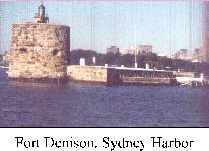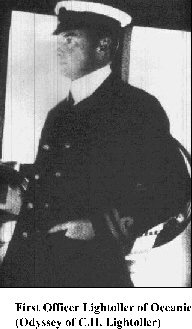
Senator Smith: What time did you leave the ship?
Mr. Lightoller: I didn't leave it.
Senator Smith: Did the ship leave you?
Mr. Lightoller: Yes, sir.
| In February 1888, when Lightoller turned 13, he began his four year apprenticeship at sea. His first voyage at sea was in a four-masted, 2,500 ton barque, Primrose Hill, who was bound for San Francisco via Cape Horn. Although Charles greatly enjoyed life at sea after an initial bout of seasickness, he found it far harder than he had ever imagined. Soon, the motto of 'grumble you may, go you must' became words he lived by, and he grew accustomed to this new difficult lifestyle. Living and working with the other boys of the half deck, he found his niche and both figuratively and literally learned the ropes. It was during this period that he discovered that he had quite an ear for music, and became quite proficient at playing the banjo. He also earned the nickname 'Lights', and requests of "Play another one for us, Lights!" became commonplace. Sometime late in this first voyage the ship was blown far off course and found herself surrounded by ice near the south pole. Consequently,he saw an iceberg for the first time in his life. In retrospect, this provides an ominous bit of foreshadowing to the events that would occur 24 years later. |  |
| While still in the planning stages, the plot thickened with the idea of raising the Boer flag at the fort. The young men figured that this would be a perfect touch, as the Boers (then at war with the British Empire) and Australia were great foes. They pooled their money, bought the supplies they would need, and secretly set about crafting a Boer flag from a bedsheet. |  Photographer: Inger Sheil |
Weeks later, on the appointed night, Lightoller and the other men set out in a leaky boat for the fort. After using a rope to climb up the side, Lightoller and one of his comrades immediately set about preparing the gun for the "One Gun Salute" while the third partner in crime raised the newly crafted Boer flag. Lights finished up his work at the gun, waited for his shipmates to make it back to the small boat, and lit the fuse.
The fuse began to burn- much more rapidly than the young officer had anticipated. He scrambled back down the wall and into the waiting boat, only to be confronted with dismal news. The wash from a passing ship had smashed the tiny craft against the rocks and holed it. Despite the frantic bailing by his two shipmates, she was still taking on water and was half full.
Desperate to get back to their ship before they were caught, Lightoller ordered the two men to row like mad as he ripped off his shirt and stuffed it into the large hole in the boat, trying in vain to stem the flooding. At the time, Sydney Harbor was shark infested, and it is no doubt that thoughts of these sharks spurred the young men along with greater urgency. At last they made it to the shore and abandoned their rapidly sinking mode of transport, mystified that the gun hadn't yet gone off.
The trio dashed through the Domain, through the gardens and grounds of Government House, and finally arrived back at Circular Quay where Medic was docked. Disappointed and convinced that something had gone wrong and their great "One Gun Salute" had been a dud, they were all startled by a blinding flash of light. Seconds later an enormous explosion shook the ground beneath their feet. They had done it!
The three young men cheered and crowed with delight, slapping each other on the back and tossing their caps up in the air. It suddenly dawned on them that perhaps they'd best pipe down a bit, as they certainly didn't want to be identified as the perpetrators of the great stunt.
Sydney, Australia found itself in a state of shock, having had their nighttime slumber shattered by the explosion and discovering the dreaded Boer flag flying proudly from their fort. It was the talk of the town, with everyone venturing guesses as to who could have pulled such a prank. As Medic sailed out of Sydney Harbour some days later, it was still the main topic of discussion, and they still had no answers.
Word leaked out, and Lightoller decided to write out his letter of resignation before he was dismissed from the White Star Line. Soon, he found himself in the office of the line's Superintendent, Captain Hewitt. Hewitt took Lightoller to task, roaring with disapproval and pointing out that what he had done could be considered an act of treason. At some length, Captain Hewitt calmed down and announced that for the record he would need to know Lightoller's version of events. Having nothing to lose, he told his story, beginning with the idea's conception and going all the way up until the blinding flash of light and earth-shaking explosion.
At this point, the normally staid and gruff Captain Hewitt burst out laughing. As tears of mirth rolled down the older man's cheeks, he deliberately took Lightoller's resignation in hand and ripped it to shreds. He concluded the interview by roaring, "Get out and get back to your ship!" Lightoller wasted no time in obeying the order, thankful to still be gainfully employed. As he walked out the door and stepped out onto James street, he could still hear Hewitt chuckling.
| However, the White Star Line decided that perhaps it wouldn't be wise to send the young officer back to Australia just yet, and he was transferred to the Atlantic run aboard another vessel for a brief period of time. Upon returning to Medic and the Britain-South Africa-Australia run, Lightoller met his future wife Sylvia Hawley-Wilson. She had a foot deformity that made it difficult for her to walk long distances, so Lightoller helped her around the ship during the entire voyage. Charles and Sylvia fell in love, and by the time Medic completed its return voyage to Britain, the two were married. They would go on to have five children together: Roger, Trevor, Mavis, Doreen, and Brian. |  |
Lightoller spent most of his career with the White Star Line aboard Medic and Majestic, under the command of Captain Edward J. Smith. While serving aboard Medic, Lightoller also met his long-time colleague and friend William McMaster Murdoch. Lightoller had a very high opinion of both. He wrote a particularly flattering passage about Captain Smith in his book “Titanic and Other Ships”:
“Captain Smith, or “E. J.” as he was familiarly and affectionately known, was quite a character in the shipping world. Tall, full whiskered, and broad. At first sight you would think to yourself, “Here’s a typical Western Ocean Captain.” “Bluff, hearty, and I’ll bet he’s got a voice like a foghorn.” As a matter of fact, he had a pleasant, quiet voice and invariable smile. A voice he rarely raised above a conversational tone-not to say he couldn’t; in fact, I have heard him bark an order that made a man come to himself with a bump. He was a great favorite, and a man any officer, myself included, would give his ears to sail under.”
| After leaving Majestic, Lightoller was promoted to Third Officer and served aboard the 17,000 ton Oceanic. Oceanic had long been considered the pride of the White Star Line. In his later years, Lightoller stated that Oceanic was his favorite post. While aboard Oceanic, Lightoller served with Herbert John John Pitman and James Paul Moody, both of whom he would serve with while aboard Titanic. | 
|